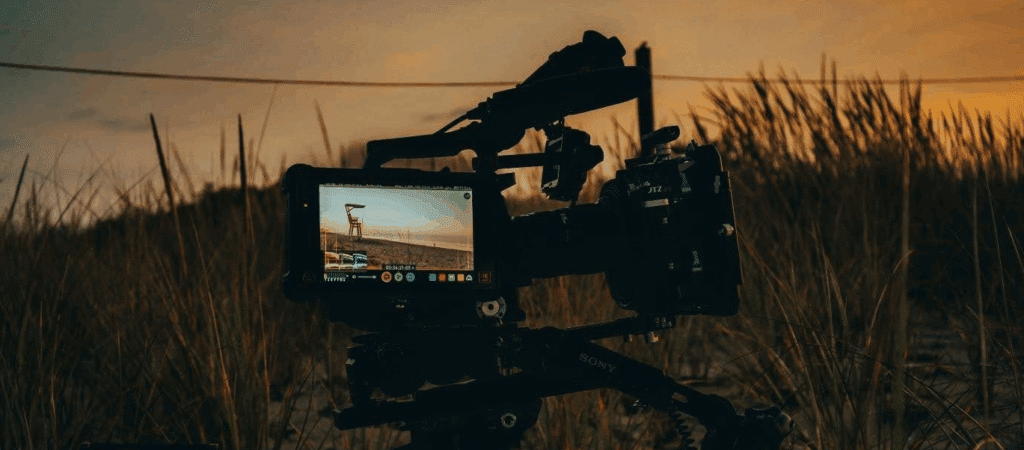
We’d hazard a guess that you’re here because you want to break into the film industry. Maybe you’re an independent filmmaker keen to secure funding to send your work into the world officially.
While it may not be a straightforward journey, 2025 offers more avenues than ever for securing that ever-valuable funding for your project. Whether it’s your first short, a passion-project, or ambitious feature film, financing can be the biggest challenge.
Don’t worry, it’s not all doom and gloom, as with the right strategy and tools, you can navigate both traditional and modern funding paths effectively.
But what are these funding paths exactly? What materials do you need? In today’s blog, we’ll cover everything you need to know about how to get film funding in 2025, including grants, crowdfunding, private investors and everything in between.
We’ll also dive into the practical materials you need to pitch your project with confidence.
“I love money more than the things it can buy… but what I love more than money is other people’s money.” – Lawrence Garfield, Other People’s Money (1991)
Let’s take the first step!

Table of Contents
- What is Film Funding?
- Traditional vs Modern Funding Paths
- Grants, Fellowships, and Film Funds
- Crowdfunding Strategies
- Private Investors and Sponsorship
- Pitch Materials
- Celtx Tools for Pre-Production Planning
- FAQ
- Extra! Extra!
- Conclusion
What is Film Funding?
Film funding is the process of securing the financial resources required to produce a film.
Funding can range from a few thousand dollars for a short film to millions for a feature-length project. The money can come from public grants, private investors, nonprofit organizations, crowdfunding platforms, and even corporate sponsors.
However, film funding isn’t just about the money. No, it’s about assembling a team of supporters who believe in your story, vision, and your ability to bring it to life.
Traditional vs Modern Funding Paths
As the industry evolves, so do the ways filmmakers source money. Of course, both traditional and modern paths are relevant, but there are pros and cons to both. Let’s explore those in more detail:
Traditional Film Funding
Traditional funding comes from studios, production companies, and government or nonprofit grants. It often involves:
- Film grants
- Fellowships
- Studio deals
- Public funding bodies (like national film boards)
| Pros | Cons |
| More stable, structured financing | Highly competitive and slow-moving |
| Access to industry connections and mentorship | Requires polished proposals and prior work experience |
| Typically doesn’t require giving up ownership (in the case of grants) |

Modern Film Funding
Thanks to the internet and digital platforms, filmmakers can now raise money through a variety of means. Such as:
- Crowdfunding platforms (Kickstarter, Seed&Spark, Indiegogo)
- Online investor platforms
- Brand sponsorships
- Social media partnerships
| Pros | Cons |
| Direct access to your audience | Requires strong marketing skills |
| More creative control | Can be time consuming and unpredictable |
| Fast feedback and validation |
For most indie filmmakers, the most effective approach blends both methods.
So now we’ve covered film funding as a whole, let’s take a closer look at some of the most popular ways to secure money for your next project.
Grants, Fellowships, and Film Funds
Grants and fellowships are still a popular and critical funding source in 2025, especially for underrepresented voices, emerging filmmakers, and social impact projects.
The types of grants available are:
- Development grants for writing scripts and research
- Production grants that cover shooting, equipment, crew, and post-production
- Finishing funds for editing, color grading, sound design etc.

So, where do you find grants? Here are some of the industry’s standout sources:
- Sundance Institute
- Women in Film and TV (WIFTV)
- National Endowment for the Arts (NEA)
- IDFA Bertha Fund (for documentaries)
- Netflix Fund for Creative Equity
- Doc Society
If you’re going to apply for any of these grants or funds, you’ll most likely need a detailed proposal, treatment, budget, and director’s statement. We recommend starting to build relationships with these organizations well in advance of applying.
For more on grants, check out this awesome article from Film Independent.
Crowdfunding Strategies
Modern filmmaking has seen many creators take the bull by the horns and make their movies themselves. That’s where crowdfunding comes in.
“The best advice I can offer to those heading into the world of film is not to wait for the system to finance your projects and for others to decide your fate.” – Werner Herzog, Filmmaker
In 2025, crowdfunding remains a top method for independent filmmakers, especially for creating grassroot support and buzz around a project.
The most popular crowdfunding platforms are:
- Seed&Spark (a film-focused, highly curated platform with educational tools)
- Kickstarter (the largest general crowdfunding platform which makes it ideal for wide reach)
- Indiegogo (flexible funding actions)
- GoFundMe (casual, donation style fundraising)

So, what’s the best way to secure crowdfunding? Well, we have tips for that:
1. Start with a strong audience
Build your email list and social media months before you launch your funding campaign.
2. Tell a compelling story
Create a campaign video that sells your script, vision, passion, and uniqueness.
3. Offer meaningful rewards
Think behind-the-scenes access, shout-outs, premiere invites and merch to entice your audience.
4. Use stretch goals
Give donors a reason to keep pushing past your initial goal.
5. Promote relentlessly
Okay, this may sound a little intense, but it’s important to keep your project at the forefront of people’s minds. Plan a 30-day marketing calendar with daily content, livestreams, and updates.
Money is only a small part of crowdfunding. It’s about building community and proves your film’s value before it’s even made. Create a buzz!
“My token advice (to aspiring filmmakers) is do it—make your own stuff. Whether it’s short films or whatever you can do, my advice is make your own stuff. I’m a real believer in preparation meets opportunity. When this opportunity (to write Bridesmaids) came along I really had been at this a long time…I was really prepared when this came along. I’m just a firm believer in ‘just do it.’ If you build it, he will come.” – Annie Mumolo, Screenwriter
Private Investors and Sponsorship
If your project has commercial potential, private investors and sponsors may be viable options for funding.
Who are Film Investors?
Private investors could be:
- Angel investors looking to support the arts
- Wealthy individuals interested in film
- Investments groups that fund indie projects for potential ROI
So, how do you attract investors like these? Well let’s now look at:
How to Attract Investors
Develop a Strong Business Plan
After all, the film business is an actual business. So, it’s crucial to outline your film’s budget, revenue projections, target markets, and distribution plan for potential investors to peruse.
Create a Pitch Deck
Next, you’ll need a creative way to display your business plan. Pitch decks usually contain visuals, the story, team bios, audience insights, and monetization.
Present Investment Incentives
As part of your pitch package, it’s wise to make your potential investors aware of the incentives in contributing to your project. Think potential profits, screen credits, tax incentives, and film festival exposure.
If you’re still looking for inspiration, Seed&Spark has a great resource on investment incentives which you can find here.

Sponsorship Opportunities
Some companies may sponsor films in exchange for product placement or branding opportunities, especially if your film aligns with their mission or audience.
- Lifestyle brands
- Tech companies
- Nonprofits
- Local businesses
As you navigate securing funding, remember this: make sure you keep artistic integrity while leveraging brand partnerships. Your vision is the most important thing!
Pitch Materials
Before you approach any potential investors, no matter who they are, you will need to prepare professional and persuasive materials.
Below are the essential pitch materials you’ll need in 2025.
1. Logline and Synopsis
A one-sentence hook and a one-paragraph summary of the story.
2. Director’s Statement
A short statement that answers these questions:
- Why this story?
- Why you?
- Why now?
3. Lookbook or Mood Board
Include visual style references such as a color palette and examples of cinematography.
4. Pitch Deck
A professional slide deck that includes the story, team, audience, visuals, budget, and distribution plan.
5. Budget Breakdown
Line-item production budget and top-sheet summary.

6. Script or Treatment
A finished screenplay or a scene-by-scene treatment.
7. Proof of Concept
A teaser, trailer, or sizzle reels can be fantastic to help bring your idea to life for potential investors.
8. Team Bios and Filmography
Include who’s involved and why they’re the right people to bring the project to life.
We recommend preparing all the above so you’re ready for every eventuality. Remember, these materials are your first impression so make them count.
Celtx Tools for Pre-Production Planning
We hate to toot our own horn, but Celtx is one of the most reliable and user-friendly tools for indie filmmakers in 2025. Our suite of cloud-based software tools help you plan, write, and manage your pre-production from start to finish.
Why Celtx? Let’s break it down:
- Scriptwriting (industry-standard formatting and collaboration tools)
- Storyboarding (visualize scenes with drag-and-drop assets)
- Budgeting and scheduling (plan your shoot down to the minute and dollar)
- Team collaboration (share scripts, notes, and updates in real time)
- Catalogs and breakdowns (track props, wardrobe, actors, and much more)
By using Celtx, you can boost your credibility with investors and funders by showing you’re organized and production-ready. It also saves time during the in-development phase and makes it easier to generate necessary documents you’ll need for the production process.

FAQ
Can I apply for multiple types of funding at once?
Absolutely. Many successful projects use a combination of grants, crowdfunding, and private investment. Just be transparent with funders about where other money is coming from.
What’s a reasonable budget for a short film in 2025?
It varies by location and ambition, but $10,000 to $50,000 is a common range. Micro-budget shorts can still succeed if the concept is strong and the production is smart.
Do I need a finished script to raise money?
Not always. For development grants and fellowships, a strong treatment may suffice. But private investors and crowdfunding backers will expect to see a script or clear vision.
What if I have no prior film experience?
Focus on your story, passion and any collaborators with experience. Partner with a DP or producer who’s done it before to lend your project credibility.
How long does it take to secure film funding?
It can take anywhere from 3 months to 2 years depending on your funding path. Plan for delays and develop parallel strategies.
Extra! Extra!
There are countless resources out there to help you secure funding for your project, but some are more helpful than others (in our humble opinion!) Here are our top picks:
- Celtx Blog (production tutorials and case studies)
- FilmFreeway (for submitting to festivals – useful post-funding)
- No Film School (industry insights and funding updates)

- Sundance Collab (workshop, feedback sessions, and funding resources)
- Seed&Spark’s Film Funding Classes (great for crowdfunding prep)
- Women Make Movies (distribution and production support for women filmmakers)
Conclusion
Film funding in 2025 is both a challenge and an opportunity. With more tools, platforms, and funding models available than ever, the path to financing your project depends on a combination of creativity, preparation, and persistence.
Whether you pursue traditional grants, modern crowdfunding campaigns, or investor pitches, the key is to believe in your story and convince others to believe in it too. Tools like Celtx can streamline your process, while polished pitch materials will open the doors to meaningful partnerships.
Don’t wait for permission. Start building your vision, assembling your team, and putting your work out into the world. With the right mix of hustle and heart, your film can get funded and get made.
Your story deserves the screen — and the funding to get there.
From budgeting to scheduling, Celtx gives indie filmmakers the tools to prove their project is production-ready.
Start planning your film with Celtx — it’s free to sign up!
Ready to take the next step? Keep building your indie film toolkit:
- Film Budgeting: Tips for Every Production Scale
- How to Write a Kick-Ass Elevator Pitch: Sell Your Script in Seconds
- How to Create a Shooting Schedule: The Essential Guide
